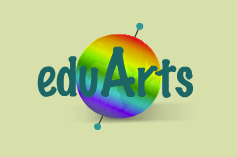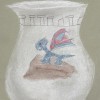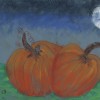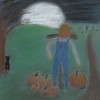Methodology & The Importance of Art

Methodology
The eduArts curriculum by Mona Brookes, the designer of the Monart Drawing Method established in 1981, is the basis of the eduArts class lesson content and structure offered at pen2paper.
This proven method combines art and academics. It builds on the concept that art is a teachable subject, just like music, dance and sports are. The method is not about copying pictures, it’s about learning how to see, interpret and commit to paper or other media. Every project has an academic component.
The instructor, Sue Hezel, completed the eduArts Certification Training course with Mona Brookes at her studio in Berkeley, CA in 2011. This certification allows Sue to use the eduArts methodology and to purchase and use the eduArts Curriculum and project plans designed by Mona Brookes. Find out more at www.EduArts.net.
Mona Brookes is the author of:
Drawing with Children
Drawing with Older Children and Teens
Drawing thru the Alphabet, for 3 to 8+
THE IMPORTANCE OF ART
Below the 10 Lessons the Arts Teach you will find in depth articles on each of these lessons written by Sue Hezel for Metro East Parent magazine.
10 Lessons the Arts Teach
1. The arts teach children to make good judgments about qualitative relationships.
Unlike much of the school curriculum in which correct answers and rules prevail, in the arts, it is judgment rather than rules that prevail.
2. The arts teach children that problems can have more than one solution
and that questions can have more than one answer.
3. The arts celebrate multiple perspectives.
One of their large lessons is that there are many ways to see and interpret the world.
4. The arts teach children that in complex forms of problem solving
purposes are seldom fixed, but change with circumstance and opportunity. Learning in the arts requires the ability and a willingness to surrender to the unanticipated possibilities of the work as it unfolds.
5. The arts make vivid the fact that neither words in their literal form nor numbers exhaust what we can know. The limits of our language do not define the limits of our cognition.
6. The arts teach students that small differences can have large effects.
The arts traffic in subtleties.
7. The arts teach students to think through and within a material.
All art forms employ some means through which images become real.
8. The arts help children learn to say what cannot be said.
When children are invited to disclose what a work of art helps them feel, they must reach into their poetic capacities to find the words that will do the job.
9. The arts enable us to have experience we can have from no other source
and through such experience to discover the range and variety of what we are capable of feeling.
10. The arts’ position in the school curriculum symbolizes to the young what adults believe is important.
SOURCE: Eisner, E. (2002). The Arts and the Creation of Mind, In Chapter 4, What the Arts Teach and How It Shows. (pp. 70-92). Yale University Press. Available from NAEA Publications. NAEA grants reprint permission for this excerpt from Ten Lessons with proper acknowledgment of its source and NAEA.
Following are the indepth articles about The 10 Lessons the Arts Teach written for Metro East Parent Magazine by Sue Hezel
Visual Arts Create Important Life Skills
February 2013 issue Metro East Parent Magazine
Don’t you wish you could bottle your child’s creativity? Since we can’t do that the next best thing we can do as parents is to nourish their interest by providing direction and instruction for growth. But how do we know what they need? Are they getting enough access to art in their school programs? Some public schools and most private schools provide art instruction, but more recently, state budget cuts and emphasis on the core curriculum have limited what schools can provide in the way of visual arts instruction. When art programs are reduced or eliminated from school curriculums it sends a clear message to parents that visual arts aren’t really that important to children. This, of course, is not true.
Plenty of research has been done showing the importance of visual arts for children. My favorite summation is the National Arts Education Association citing of the 10 Lessons the Arts Teach from the book “The Arts and the Creation of Mind” by Eisner, E., chapter 4, What the Arts Teach and How it Shows (pp. 70-92)
I think there’s a lot of merit to a parent in considering these points and since you probably won’t see these coming home on a flier from school anytime soon I’d like to share them with you as a start to the State of the Arts monthly column in Metro Parent Magazine. So here we go… here’s the first lesson and what it means to your child’s developing mind.
1. The arts teach children to make good judgments about qualitative relationships. Unlike much of the curriculum in which correct answers and rules prevail, in the arts, it is judgment rather than rules that prevail.
Wow, think about that – art lacks the right or wrong, black or white boundaries that most school disciplines inherently have. Art prompts creativity simply because there are no rules! And, ‘no rules’ is precisely why art is so much fun and so engaging. If you’ve ever had to make a child stop on their artwork, well, the response you get is usually way different from asking them to stop doing math! Art becomes an area where a child can always excel on their own terms because his/her own terms are all that matters – how refreshing and empowering!
Art invites the child to experiment and to use his own judgment from his own perspective. No other subject in school welcomes the creative process that a child’s brain accesses when given the opportunity to use art to convey… anything! It pushes the child to use his/her fine motor skills, to imagine, to try new things and importantly to reconsider what they already know.
Another unique facet of the arts is that you can be on both sides of it – creator or viewer – and find appreciation from both angles. Why did you use those colors? How did you know how to draw that? What do you think when you see this? How does it make you feel? What does it remind you of? The skill we need for that is judgment.
As parents, we want our children to develop important life skills. The unique nature of visual arts teaches some rather important ones. The use and purpose of visual arts to convey meaning, deliver a message, share a view, or invoke feelings serve to invite judgment. Few other disciplines have room for judgment. When I consider the dictionary listing for judgment, the significance really sinks in – it’s the ability to access, discern, compare, form an opinion, appraise, estimate, view, conclude, diagnose.
Electrodes would literally light up all over the child’s brain as it searches through what it knows and what it questions in order to convey simple to complex images. These thought processes apply not only to the subject matter but also to the elements used – the surface choice, the medium, the colors, etc. for a simple two-dimensional representation.
Art is an interpretation, a perspective, a stamp in time. Qualitative relationships are everywhere in a simple piece of art. By thinking through the creative process given the tools to work with and considering the subject matter one can make a multitude of choices based on judgment.
The Take Away…
Assess your child’s art program and if you or your child feels they aren’t getting enough quality art instruction then it may be time to consider seeking it outside the classroom. There are a number of art education facilities in the Metro East area. As a parent, it’s up to you to check out how the class works and if it is a good fit for your child. Just because class times align with an opening in your schedule doesn’t mean it’s really the best fit. Consider age appropriateness and whether the classes are designed to develop skills through education or if they are craft or project oriented. Some studios will let you try a class free and most don’t require a long-term commitment. The benefits are huge!
Sue Hezel is the owner of pen2paper art studio in Columbia, IL. The eduArts method, founded by Mona Brookes, is taught by Sue to children ages 3 to 103 at the studio and offsite. At pen2paper art studio, a dozen professional artists teach a variety of art instruction, from photography to clay sculpture, and every kind of drawing or painting class.
Visual Arts: Creating Awareness of Multiple Solutions and Answers
March 2013 issue Metro East Parent Magazine
In this second article of the State of the Arts column, I cover the second lesson from the National Arts Education Association’s citing of the 10 Lessons the Arts Teach from the book “The Arts and the Creation of Mind” by Eisner, E., chapter 4, What the Arts Teach and How it Shows (pp. 70-92).
2. The arts teach children that problems can have more than one solution and that questions can have more than one answer.
As parents, the concept of multiple solutions seems obvious; we are bombarded by decisions everyday that have more than one positive outcome. However, most traditional subjects in school rely on convergent thought. Typically, students crunch their knowledge base and funnel, or converge, specific data related to the question to yield correct answers. Often, the solution is the only correct answer.
- Math: 100 x 5 = X
- Literacy: Mrs. Smith wrote a story for the children to (read, reed).
- Science: What do you get if you bond two molecules of hydrogen and one molecule of oxygen together?
- Geography: The state of Illinois is (east, west) of Missouri.
The Arts utilize open-ended solutions to answer a question or problem. Within the broader Fine Arts family, visual art is generally the most accessible to personal interpretation and uses the most divergent thought process. Divergent thinking utilizes the student’s entire knowledge base including senses, motor skills, personal experiences, and emotional responses to answer the question. Some examples:
- Music: Play the note “C#” on a piano. Interpretation can affect how long the note is held or how soft or loud it’s played.
- Dance: Perform the dance routine. Dancers may choose to improvise a section or add extra movement to impart individualism.
- Theatre: Read your lines. Adjusting tone, volume, and posture can create a personalized conveyance of the script.
- Visual Art: Draw a tree. Students may consider and choose the type of tree, with or without foliage, its size on paper, position, color or black and white, surroundings, perspective, or the medium used to demonstrate personalization.
Whether a kindergarten teacher or an 11th grade art teacher asks his/her class to draw an apple tree, the answer involves a drawing of a tree based on the student’s interpretation. The students link the ‘tree’ to a visual image and then utilize their fine motor skills to put their thoughts to paper. Their drawings are the answer to the problem, “Draw an apple tree”, and they are completely unique to each student.
And each and every drawing is correct!
What an assortment of correct answers to collect! It’s engaging and practical for young minds to understand there can be more than one correct answer. Open-ended problems lead to open-ended discussions and higher critical thinking. Also, divergent thinking allows for more students to join in conversations, due to the fact that students no longer fear not having the correct answer. What a pleasant endorsement of both diversity and unity in a classroom!
The Take Away…
Regardless of the art education in your child’s school, you can help your child develop their divergent thinking skills with art at home. A parent doesn’t need to be ‘artistic’ to help their child realize the benefits of visual arts. Parents: teach your child that it’s not about the end product! Don’t get frazzled and don’t be judgmental! Keep the focus on the journey of the creative process – that’s the part that is so beneficial. Keep it fun and simple. Remember that art, like anything else, is teachable and practice yields improvement.
Sue Hezel is the owner of pen2paper art studio in Columbia, IL. The eduArts method, founded by Mona Brookes, is taught by Sue to children ages 3 to 103 at the studio and offsite. At pen2paper art studio, a dozen professional artists teach a variety of art instruction, from photography to clay sculpture, and every kind of drawing or painting class.
Visual Arts: The Multiple Perspectives of Visual Art
May 2013 issue Metro East Parent Magazine
In this article about visual arts, I cover the third lesson from the National Arts Education Association’s citing of the 10 Lessons the Arts Teach from the book “The Arts and the Creation of Mind” by Eisner, E., chapter 4, What the Arts Teach and How it Shows (pp. 70-92).
3. The arts celebrate multiple perspectives.
One of the significant lessons of visual arts is that there are many ways to see and interpret the world.
Your perspective or mental view, however deduced through experience or knowledge, is unique to you. This outlook is different from your child’s; therefore, it is unique to him or her as well. What you perceive when you view art can be very personal. Emotional responses and past experiences are as unique for you as it is for each viewer. No other discipline can boast this dynamic like the arts.
Dual perspective is involved in art– that of the artist and of the viewer. As the artist we attempt to convey our perspective of the subject. We can express that in a variety of ways. Given the same image, the artist can direct or influence the viewer’s perspective through intentional rendering. A hazy pastel image will elicit a different response than a sharply contrasted pen and ink image. The artist’s use of technique and mediums influences the expression they achieve, both instantaneously and over a lifetime. The arrangement of items in a drawing, the effect of light to soften or sharpen shadows, and the angle of figures or landscapes are just a few ways to manipulate a viewer’s experience. The possibilities are endless. It stretches the mind to think of all the ways one can render a piece of artwork to tell a story, set a mood, explain a situation or invoke a feeling…from an individual perspective.
As a paid or commissioned artist, the art rendered is an attempt to portray the requested perspective. It is a very thought-provoking exercise when the artist needs to see and understand from another’s point of view and create something of artistic value.
We all have perspective we yearn to share. The idiom “A picture is worth a thousand words” is quite true. Sometimes, words can be too descriptive and direct, whereas an image knows fewer boundaries of expression. Try expressing yourself using art. Embrace the freedom to do so from your unique perspective!
The Take Away…
Here’s a fun, easy, and creative drawing exercise you can do with your child that draws on sharing different perspectives.
The next time you have to wait at a restaurant or doctor’s office, instead of your child retreating in to his or her electronic media-cave, use the time to play together. Make several rows of quarter-sized circles on a piece of paper. Take turns making something simple out of the circle. Examples may include a peace sign, a magnifying glass, or a globe. Ok, it’s your turn! Your perspective will direct your creativity and inspire others and theirs will open your mind as well.







